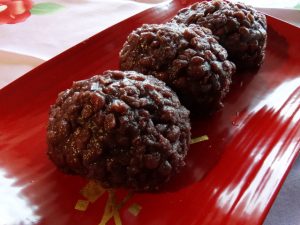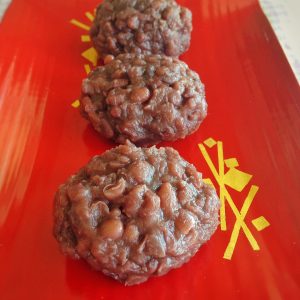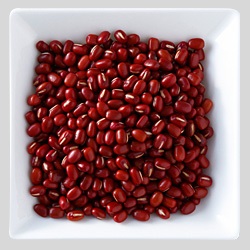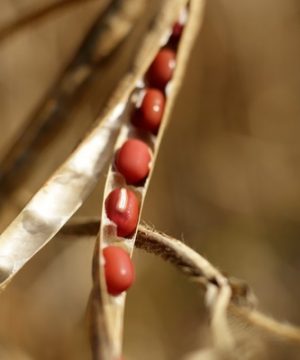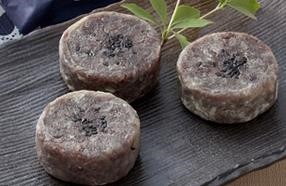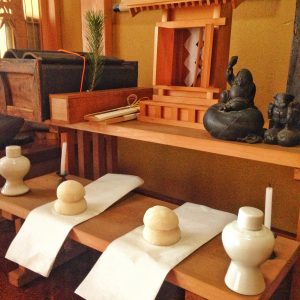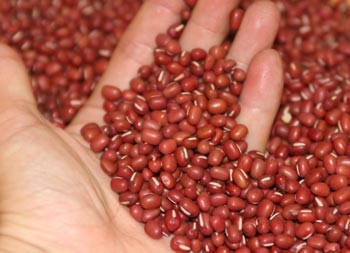
About Azuki
It has low calorie
… Koshi-Ann(red beans paste) has half as much calorie as shortcake.
You may think that Anko is sweet and therefore you will get fat by eating them. However, truth is that it has only half as much calorie as shortcake. Waggishi has relatively lower calorie in comparison with western sweet. Also Azuki, which has a lot of necessary nourishment in order to keep you healthy makes up for the most part of Wagashi.
It has a lot of dietary fiber
… Dietary fiber is something that bacteria in intestine feed on and reduce the risk of intestine cancer.
This is the most prominent feature that Azuki has. Beans, crops, sea weed and vegetables are known for containing a lot of dietary fibers. 100g Azuki has 17.8g dietary fiber which is three times as many as Gobou. Recently less and less people obtain enough dietary fiber as people acclimatize themselves to the western diet style. It absorb and keeps water in your stomach and adds bulk to the stool, which alleviates constipation. It also speeds the passage of foods through the digestive system, which facilitates regular defecation. It balances intestinal pH and stimulates intestinal fermentation production, which may reduce the risk of colorectal cancer.
It has a lot of vitamin
… It helps you keep beautiful skin.
vitamin b1 : Helps the body metabolize fats and protein and reduces your fatigue
vitamin b2 : Helps the body metabolize fatsa
vitamin b6 : Helps the body dismantle protein, such as cells, skin, hair, and nail.
Azuki contains 0.45 vitamin B1 in 100g. This is almost the same amount of vitamin that pork has. Vitamin B1 is known for metabolizing carbon and reducing the fatigue. It also contains vitamin B2, which metabolizes fats and vitamin B6, which facilitate dissolving protein and reproduces cells, skin, hair and nail. It helps you keep beautiful skin.
It has a lot of mineral
… You can obtain twice as much mineral as spinach by eating Daihuku. It also has a lot of Kalium that has positive effect on anemia and high blood pressure.
It contains a lot of iron and kalium. Iron is mostly composed of red blood cell’s hemoglobin. Lack of iron may lead to anemia because the body part can’t take enough oxygen. As I said before, you can obtain twice as much mineral as spinach by eating Daihuku. The most effective prevention against high blood pressure is abstaining from salt, but taking a lot of kalium has the important role, striking the balance between Na and K. Banana has a large amount of K. However Azuki has four times as much K as banana.
It has necessary amino acid.
… It meats the standard of necessary amino acid( nine kinds of amino acid that people can’t generate on their own)
The nine kinds of amino acid that we can’t produce by ourselves are very important. Since Japanese staple crops :rice has very little lysin (only 61 percent of average amount), you need to cover this amino acid in other ways. Azuki has abundant lysin.
It has the best antioxidants properties.
… It is said that active site of an enzyme cause aging, cancer or other disease. Azuki contains a lot of antioxidants, polyphenol which get rid of the active site of an enzyme. And the amount of it is twice as much as red wine, no less. ( It is also certified that Azuki made in Japan, more specifically in Tokachi has a large amount of polyphenol)
The amount and effect of antioxidants can be different depends on where they are made and when they are made. This is because there is a correlation between how long they received sunlight and antioxidant effect. The longer they received sunlight and the later they bloom, the more effective antioxidant they have. Polyphenol Azuki has are catechin, catechin glucoside, rutin, proanthocyanidin, cyanidin. Catechin glucoside is the pivotal component. However, polyphenol are easy to be dissolved in the water so when you boil Azuki, those components disperse into the water. It would be more effective if you used the water that are used to boil Azuki.
in 100g Azuki
Calorie
Protein
Fat
Carbon
cinder
Vitamin A
Vitamin D
Vitamin E Tocopherol
Vitamin K
Vitamin B1
Vitamin B2
Niacin
Vitamin B6
Vitamin B12
Folate
Pantothenic acid
Vitamin C
Cholesterol
Dietary fiber (Soluble fiber)
Dietary fiber (Insoluble fiber)
Dietary fiber (total amount)
Azuki … Azuki grows small yellow flowers from the end of July to the end of August. Those small flowers become red Azuki and bring beautiful color and nice flavor to our dining table. Azuki is very important not only from cultural perspective but also from nourishment and health perspective.
